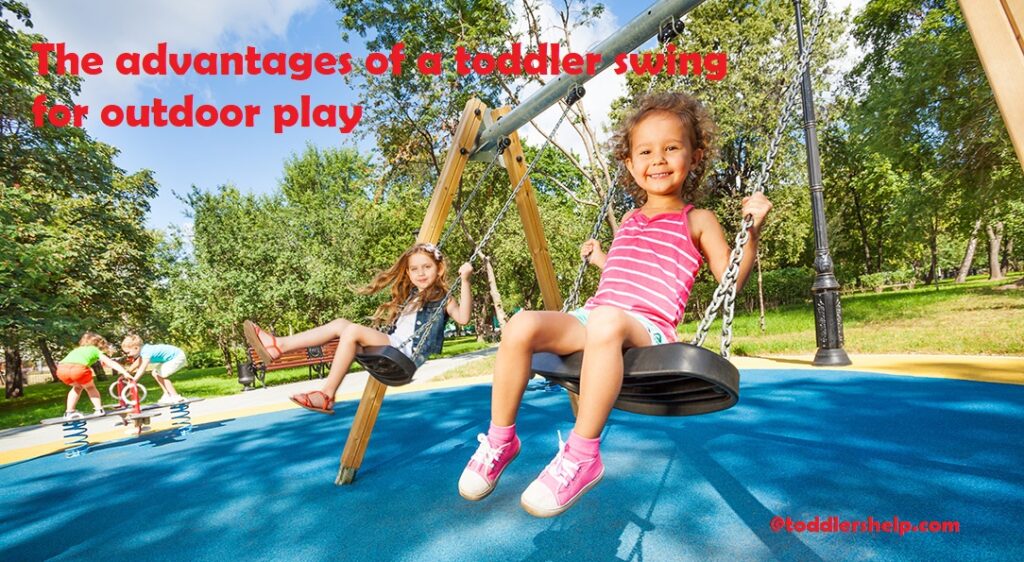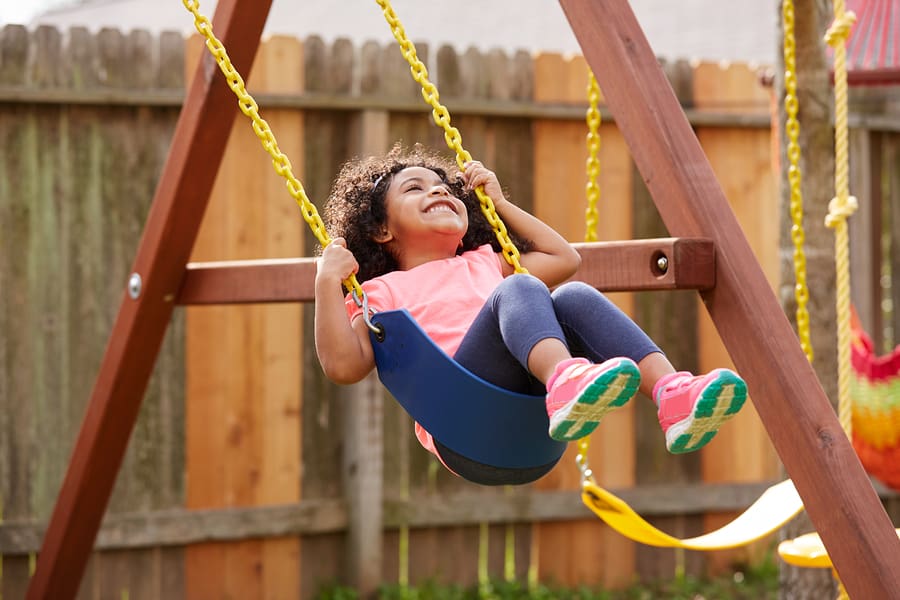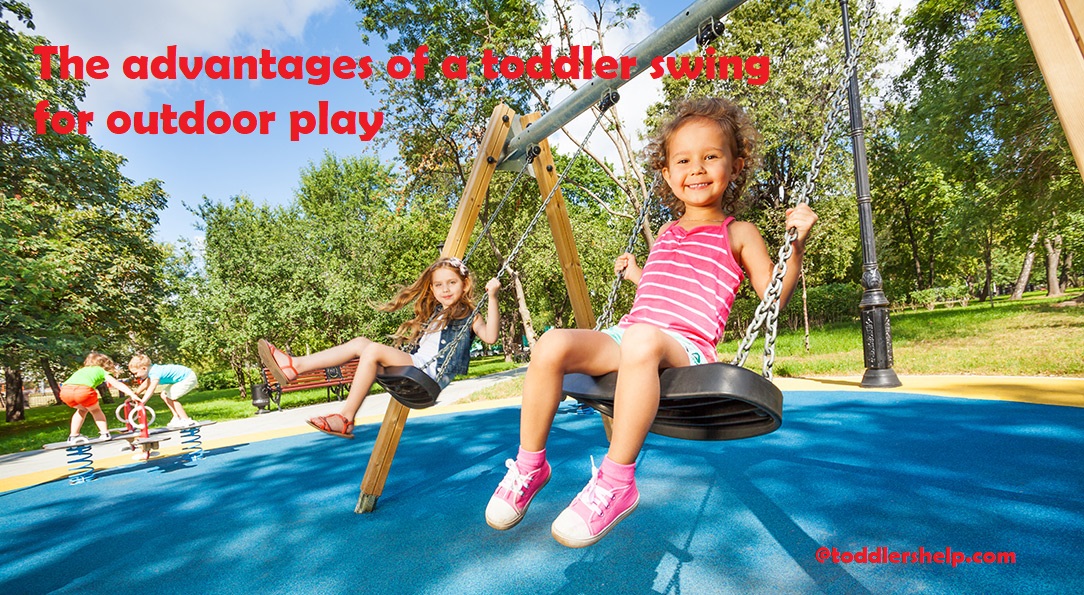With the pandemic issues, outdoor play has become essential for toddlers and parents to keep them both fit and safe. You can’t deny the benefits that a toddler swing provides – offering thrilling yet safe moments outdoors.
In this guide, we’ll discuss all the advantages of having a toddler swing for outdoor play. So buckle up, as we are about to take you through this amazing journey!
The use of toddler swings for outdoor play is a popular choice for young children. This guide will provide an overview of the different types of swings available and the benefits they offer. It will also discuss tips and recommendations for keeping children safe while using these swings. Finally, it will include information on how to properly care for and maintain toddler swings.
Toddler swings provide a fun, stimulating activity that encourages physical activity, interaction with other children and development of gross motor skills. They are also beneficial for developing balance, coordination, strength and cognitive development. Using the right type of swing in an appropriate environment provides both physical exercise and mental stimulation.
The purpose of this guide is to inform parents on the pros, cons, safety guidelines and maintenance needs associated with toddler swing sets. It also seeks to help parents decide which type of swing set would best suit their needs in terms of size, usage frequency and budget. With this information in hand, parents can make a well-informed decision about purchasing a quality swing set that fits their family’s requirements.

Explanation of toddler swings
Toddler swings are a popular choice for outdoor play for children between the ages of 1 and 5. They come in many shapes and sizes, from plastic baby swings to wooden toddler swings. In addition to being lots of fun, swing sets provide your toddler with physical and cognitive development opportunities. Swinging is an enjoyable activity that also helps children learn balance, timing and coordination while providing them with a sense of independence.
One of the main benefits of having a toddler swing is that it presents your child with a safe, secure place to play outside where you can keep an eye on them while they swing in comfort. Most toddler swings have safety lead clips that attach to the swing’s chain links or straps, which ensure they cannot slip or be injured while swinging. The close proximity allows you to supervise your child as they explore their surroundings in the great outdoors.
Another advantage of having a toddler swing at home is that it fosters cognitive development by allowing your child to practice kinesthetic learning — learning through movement and hands-on experiences — as well as encouraging risk-taking behavior such as trailing their legs, pushing off from support posts and testing different swinging strategies. These activities help develop spatial awareness, fine motor skills, vestibular functioning (how we sense up versus down) as well as aiding language and social development through relaxed conversation between friends or parents who may be swinging too!
Importance of outdoor play for toddlers
Outdoor play for toddlers is an essential part of development, helping children to explore, learn and grow. When sheltered in the safety of a toddler swing, not only do they feel physically safe and secure, but they are also stimulated mentally and socially. Being outdoors provides stimuli in the form of sights, smells and sounds that cannot be found when inside a home or building. It helps them to develop coordination by moving, twisting and turning their body as they swing. It also helps improve their balance as their bodies learn to both adjust to all kinds of changes in motion while learning how to find balance on a single point at the apex of each swing.
Being outdoors further encourages exploration by giving toddlers a wide range of activities and opportunities to interact with the environment around them – such as finding bugs hidden in playful places or collecting amusing stones from the garden. Furthermore, it aids hand-eye coordination as toddlers practice aiming for targets by throwing objects or using tools found outside. Aside from these physical advantages, spending time outdoors teaches important life skills such as building relationships with other people through play or developing communication skills with others through stories or songs shared under the sun’s rays. Above all else, it provides moments for creativity that can span from sand castles made near shorelines or mud pies being cooked up nearby; never underestimate just how much fun toddlers can have playing outside!
Benefits of toddler swings for outdoor play
Using a toddler swing for outdoor play offers many benefits to both the child and parent. By incorporating motion and coordination, as well as storytelling and imaginative play, a toddler swing can be an important and exciting element in outdoor activities.
Toddler swings provide many different kinds of physical benefits. The effort of pushing, swinging, and jumping can help build gross motor skills essential for development. Motion encourages coordination as the child learns to move their legs in a balanced way while also managing stability through their upper body. This type of movement strengthens coordination on both sides of the body, helping to develop muscles used for running and other activities in the future. In addition to the physical benefits, toddlers also receive the mental stimulation of problem-solving when they are playing on and interacting with their swing.
The environment around a toddler swing allows important cognitive play while encouraging development of language skills through storytelling and roleplay opportunities with adults or other children nearby. They can practice interacting with others while they explore different types of imaginative activities provided by a swing set, such as hide-and-seek or acting out stories that they have seen come alive within the context of their imaginative playtime on the playground equipment swingset.
Finally, time spent on a toddler’s playground equipment such as swings provides an opportunity for positive self-expression without fear or judgement from others; allowing children to push boundaries safely, within parental guidelines allows them to experiment without attachment or risk for failure which is essential for confidence building in early childhood development stages. A playground with swings sets up exploration opportunities that are not contained indoors but instead engage them with nature whereas indoor toys focus more on interactive or imaginary play; allowing children to observe how nature interacts along side them in addition to boosting physical activity means kids get even more out of their long hours outdoors at home or at park.
Physical development: improving balance, coordination, and muscle strength
Toddler swings have many benefits for physical development. On top of improving balance, coordination and muscle strength, they also encourage outdoor time and physical play, something that is crucial for a child’s development.
The repetitive motion of swinging helps toddlers to develop strong arms and legs to support their growing body weight. Additionally, the act of balancing on the swing helps to reinforce their sense of in-out-balance when playing indoors or outdoors. The back-and-forth motion also encourages hand-eye coordination as kids learn to coordinate their body movements with their vision while attempting to control the momentum.
Furthermore, swings can improve a toddler’s fine motor skills as they use their hands to hold onto the ropes while swinging themselves back and forth. Finally, prolonged outdoortime on a swing can help improve cardiovascular health by physically pushing themselvesto higher heights in effort to accomplish the goal of swinging higher each time.
Emotional and social development: boosting confidence and social skills
Toddler swings are an excellent way to enhance emotional and social development. The use of a swing helps toddlers become more confident and independent, as they can choose to swing high or low based on their own comfort level. Swinging also encourages the development of coordination through physical movement.
Additionally, group play on the swing can help toddlers learn about turn-taking and teamwork. Forcing children to consider other people’s feelings fosters empathy skills and allows them to gain a better understanding of how their actions affect others. The act of interacting with other children while swinging also promotes language development, as they will be exposed to more complex vocabulary in comparison with solitary playtimes.
Swinging is an excellent way for small kids to receive all these valuable experiences while having fun at the same time!
Safety considerations for toddler swings
Toddler swings need to meet all safety requirements for playground equipment. Before you purchase a swing for your toddler, it is important to review the safety features. Look for features such as a full-width U-bar at the top of the swing and an overhead support bar. It is also recommended that when choosing a swing, you select one that has a wide seat and non-slip grips. Some swings also come with a bow knot that allows you to easily adjust the seat’s height so your child can safely use it without fear of falling out.
Additionally, make sure that components like the chains, ropes, or plastic straps are not frayed or damaged in any way. It is also important to check that there are no sharp edges on any of the parts in order to protect your toddler from getting any cuts or scrapes. Finally, make sure all fasteners are securely tightened and regularly inspected for wear and tear before each use.
Age-appropriate swings
Toddlers and young children need to be kept safe when they’re playing outside, and age-appropriate swings provide a fun way to do this. Swings designed specifically for toddlers provide the right height and stability for even the tiniest of riders, creating an enjoyable outdoor experience for all ages. Such swings are available in a variety of shapes and sizes – from traditional single swings to double sets with canopy roofs – providing plenty of freedom to explore their surroundings.
For toddlers who are fast growing, adjustable swing heights are a must-have. These swings can adjust as your child grows, enabling the whole family to join in on the fun while making sure all users remain safe. Parents will appreciate how easy it is to switch settings between adults and toddlers since no tools are required.
Even young children enjoy their independence, which is why you should look for a toddler swing that features access ramp frames for easy maneuverability into and out of the seat. This will also help parents lower their stress levels as they keep an eye on their child when out playing in the garden or park. A stable metal frame with steel reinforced fascia boards constructs these frames and provides strong lumbar support without compromising on comfort – perfect for budding adventurers!
Proper installation and maintenance
It is important to ensure that the proper assembly and maintenance requirements are met when installing a toddler swing outdoors. For instance, it should be secured to a sturdy surface such as concrete, asphalt, or well-packed soil with either surface anchors or post spikes.
It is also essential to check the welds around the frame for any cracks, as this could reduce its stability and result in injury or accident. Additionally, it is important to regularly wipe down and inspect the parts for signs of wear or tear and replace them as needed. As part of regular maintenance, make sure all screws are tightened down before each use.
Furthermore, make sure that the swing has a maximum weight limit tailored to suit your child’s size and age group. Finally, ensure that your swing has padding on all metal sections that are exposed to contact with small feet such as chains and loops.
By following these safety recommendations, you will ensure that your toddler swing is usable in the safest way possible over time.
Adult supervision
It is important for parents to remain present and actively supervise their children when playing in a toddler swing. As with any playground equipment, it is essential that any toddler swing be used only under direct adult supervision. The American Academy of Pediatrics recommends that no child play unattended on playground equipment.
An adult should always be close enough to respond quickly in case of injury or the child leaving or entering the swing while another child is swinging. Adult supervision should also prevent quarrels over who has the turn on swings, slides and other areas of play.
Types of toddler swings for outdoor play
When choosing a toddler swing, it is important to understand the different types available and the features they offer. Here are four popular types of toddler swings for outdoor play:
-High back bucket swings: High back bucket swings provide toddlers with extra support and security. They feature a front or rear facing design, with some models offering adjustable straps or reclining positions. This type of swing is beneficial for toddlers who desire a bit more security in their playtime activities as they can securely sit upright in a guarded setting.
-Belt swings: Belt swings are slip-resistant and consist of adjustable straps that connect from the frame to the seat base. The straps are securely fastened around the waist, providing extra support and comfort for young children during their playtime activities.
– Toddler saucer swings: Toddler saucer swings are another popular option for younger children outdoors due to their fun shapes and bright colors that add an element of excitement and fun to outdoor playtime. The spacious design allows multiple children to ride on it at once, making it ideal for backyard parties, family gatherings, parks or playgrounds.
-Baby seat swings: Baby seat swings are specifically designed for babies up to 24 months of age who can’t hold onto traditional belt or high back bucket seats because they don’t have full head or neck control yet. This style of swing is equipped with supportive sides designed to protect your baby while free swinging on a secure platform.
Bucket swings
Bucket swings provide a sense of comfort and security to young children because of the backrest and sides which makes for a snug fit for the user. This type of swing also prevents your toddler from sliding out when swinging high. Bucket swings are available with two different types of seats. The traditional model is designed with a molded plastic seat, while the basket weave seat option is made with plastic coated chains which provide extra ventilation during those hot summer days. Again, whichever style you choose, it’s important to get one that comes with both adjustable straps and loops in order to maintain the highest levels of safety for your child.
These types of swings can be hung on a standalone structure such as a playset or mounted onto existing secured beam. Considerations should be taken when installing any bucket style swing onto an existing structure; strength, load capacity, height and versatility should all factor into making your choice.
Conclusion
In conclusion, the use of toddler swing sets in outdoor play provides several benefits for children. These include improved physical and emotional development, better body coordination and balance, increased strength and endurance, heightened curiosity, enhanced problem solving skills and creativity, increased sense of accomplishment, improved social behavior and the ability to play independently.
Additionally, access to a safe and stimulating playground environment gives children the opportunity for unstructured play in an age appropriate manner. Therefore, it is recommended that parents utilize toddler swing sets as a key component when designing or creating an appropriate outdoor play area.
FAQ’S
What are the benefits of swinging for toddlers?
Swinging for toddlers can provide a variety of benefits, such as improving balance and coordination, strengthening muscles, promoting sensory integration, providing a sense of independence and freedom, and enhancing cognitive development.
What is the benefit of baby swing?
The benefit of a baby swing is that it can soothe and calm babies, providing a safe and comfortable environment for them to rest and play, while also promoting visual and auditory stimulation.
What are the sensory benefits of swinging?
Swinging can provide sensory benefits for individuals of all ages, including the stimulation of the vestibular system, which can improve balance, coordination, and spatial awareness, as well as the regulation of sensory input, leading to decreased anxiety and increased focus.
Is swinging good for brain?
Yes, swinging can be good for the brain, as it can promote the development of neural connections and enhance cognitive function, including attention, memory, and problem-solving skills.
What are swinging activities for toddlers?
Swinging activities for toddlers can include traditional playground swings, as well as indoor swings, hammocks, sensory swings, and other variations, such as spinning swings or platform swings.
Is swing good for baby brain?
Yes, swinging can be beneficial for a baby’s brain development, as it can provide stimulation to the vestibular system, enhance visual and auditory processing, and promote relaxation and stress relief.
How long should a toddler swing?
The duration of time a toddler should swing can vary depending on their age and development, but generally, it is recommended to limit swinging to around 15-20 minutes per session to avoid overstimulation or fatigue.
How does a swing and slide help a child development?
A swing and slide can help a child’s development by providing opportunities for physical activity, gross motor development, spatial awareness, socialization, and sensory stimulation.
Are swings safe for toddlers?
Swings can be safe for toddlers when used properly and with appropriate supervision. It is important to ensure that the swing is age-appropriate, properly installed, and that the child is properly secured in the seat.
Do toddlers like swings?
Many toddlers enjoy swinging, as it can provide a sense of excitement, joy, and freedom, as well as opportunities for exploration and play. However, each child is different, and some may not enjoy swinging or may need time to adjust to the sensation.
See Also-
- Best toddler winter coat
- Best toddler winter boots
- Best toddler water table
- Best toddler water shoes
- Best toddler wagon

